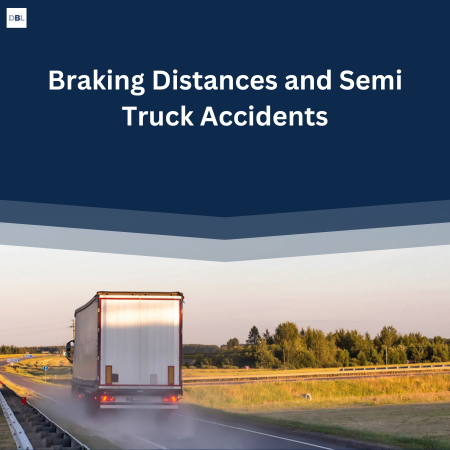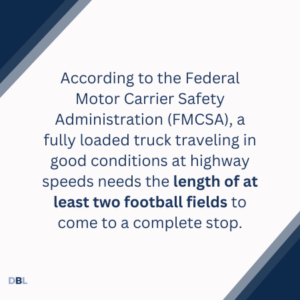
Most South Carolina drivers know that the enormous size difference between passenger vehicles and large trucks can make any type of collision deadly. But many drivers don’t realize how much space truck drivers actually need to come to a full stop. Understanding the importance of giving a truck adequate braking distance can go a long way toward preventing serious crashes.
Both truck drivers and other motorists have a duty to respect each other’s stopping distances. If they fail to do so and cause an accident, they can be held liable for any injuries and damages they cause.
Have you been hurt in a semi-truck accident in Lancaster? At David Blackwell Law, we can help you pursue compensation for your medical costs, lost income, lost earning potential, pain and suffering, and more.
An experienced S.C. truck accident lawyer is just a phone call away. Call or contact us now for a free consultation.
What Are Braking Distances?
 Braking distance refers to the amount of space a vehicle requires from the time the brakes are fully applied to when it comes to a full stop. A vehicle’s braking distance is largely affected by the speed it is traveling when the brakes are hit and the effectiveness of the friction between the tires and the road surface.
Braking distance refers to the amount of space a vehicle requires from the time the brakes are fully applied to when it comes to a full stop. A vehicle’s braking distance is largely affected by the speed it is traveling when the brakes are hit and the effectiveness of the friction between the tires and the road surface.
Trucks have much longer braking distance than the average vehicle. According to the Federal Motor Carrier Safety Administration (FMCSA), a fully loaded truck traveling in good conditions at highway speeds needs the length of at least two football fields to come to a complete stop. The stopping distance of a truck can also be impacted by its braking system, weather, and the size of the load that it is carrying.
Car vs. Truck Stopping Distances
The FMCSA outlines the stopping distance required for both passenger vehicles and semi-trucks:
- A standard passenger vehicle traveling at 65 miles per hour will require approximately 300 feet to come to a full stop.
- A fully loaded commercial truck going at the same speed needs approximately 600 feet to stop.
Other factors impact a vehicle’s stopping distance, such as:
- Reaction time: How long it takes a driver to mentally process that they need to stop.
- Size: The size and weight of the vehicle will affect its braking distance.
- Brakes: Cars and trucks have different braking systems, which can impact how quickly they are able to stop.
Truck Braking Systems
Most trucks use an air brake system, which relies on an extensive combination of pumps, storage tanks, and valves to monitor the pressure within the system. When the storage tanks in these systems are empty, the brakes are deployed. To release the brakes, the storage tanks must be completely filled with air, a process that is known as recharging.
When a trucker is inside the cab, deploying the braking system works very similarly to the way it works inside a passenger vehicle. The driver only has to press the brake pedal to bring the truck to a full stop. The difference is that instead of hydraulic fluid being forced into the brakes, the truck’s brake pedal releases air from the storage tank. It takes more time for air brakes to engage, which is one of the reasons why trucks have longer braking distances.
How to Avoid a Semi-Truck Accident
Take precautions to avoid a semi-truck accident by:
- Learning the No Zones: The No Zones refer to the very large blind spots that trucks have on all sides. Understanding where the No Zones are — and staying out of them —is crucial when staying safe around trucks.
- Yield to trucks changing lanes: Many motorists do not want to drive behind a truck because they move more slowly. Still, it is important drivers do not speed and try to move past a truck quickly. This can trap drivers in a No Zone, making it harder for the truck driver to see them.
- Be aware of a truck’s limited braking power: One of the most dangerous things any motorist can do is to pull in front of an 18-wheeler and slam on the brakes. Failing to provide a truck with enough stopping distance will greatly increase the chances of a crash.
- Always give trucks the room they need: Tailgating, speeding, failure to yield, and other dangerous driving behaviors can make it difficult for even the best truck drivers to stop in time to avoid a wreck.
Who Is Liable for a Truck Accident?
After a truck accident, many people assume that the truck driver’s negligence, or recklessness, was the direct cause of the crash. In some cases, this is true. Truck drivers are expected to drive in a reasonable manner at all times to keep everyone safe on the roads. When truckers do not give themselves enough stopping distance by driving recklessly, they can be held liable for an accident and any resulting injuries.
However, truck accidents are not always the fault of the trucker. In some cases, a crash may be caused by defective brakes. Truck manufacturers are responsible for ensuring that all of their products are safe. If a design defect caused an air brake failure, the maker of the faulty part can be held liable.
Other potential defendants in a truck accident case include the trucking company, cargo loader, companies in charge of maintenance and inspections, and other drivers.
What Can David Blackwell Law Do For Me?
 The key factor that determines whether you can obtain compensation after a truck accident is proving negligence. You must be able to establish that the at-fault party had a duty to keep you safe, and that your injuries were a result of those negligent actions. A South Carolina truck accident lawyer at David Blackwell Law can investigate your case and collect evidence to build a strong claim for compensation on your behalf.
The key factor that determines whether you can obtain compensation after a truck accident is proving negligence. You must be able to establish that the at-fault party had a duty to keep you safe, and that your injuries were a result of those negligent actions. A South Carolina truck accident lawyer at David Blackwell Law can investigate your case and collect evidence to build a strong claim for compensation on your behalf.
In general, you have three years to file a truck accident claim in South Carolina. However, the deadline may be extended or shortened based on the facts of your case. Don’t miss out on the money you deserve based on a technicality. Schedule a free consultation with David Blackwell Law today.
